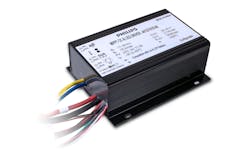Hoping to make solar-powered street lights a more viable option in less sunny environments, Signify will begin outfitting its photovoltaic-equipped luminaires with a controller that toggles the electricity between solar and the grid depending on conditions.
“Signify’s new integrated Philips Combo Charge Controller enables the emergence of hybrid solar systems,” the company said. “These enable street lights to use clean solar-powered electricity when there is sunshine and the mains grid at other times. This is expected to open up new markets for solar-powered lighting.”
The luminaires store solar electricity in a battery that powers the street lights at night. With the new “hybrid” approach, batteries require only a day's worth of sun, because grid electricity can take over, “whereas off-grid solar lighting systems typically need up to five days of panel and battery capacity,” Signify claimed.
The new controllers also make it possible to boost lumens to 24,000. Levels top out at 13,500 lm without the controller. With the controller, efficacy increases to 175lm/W, compared to 140 lm/W without. Performance can be monitored remotely using wireless technology, Signify said.
Signify is supporting brightness levels down to 5000 lm, in an effort broaden applications to include pedestrian paths and other areas in addition to roads.
“There are still more than one billion people living in communities that aren’t connected to the electricity grid," said Harsh Chitale, head of Signify’s Business Group Professional. “Solar-powered lighting can greatly improve road safety and transform life in rural communities. And with this new technology we can also bring the benefits of solar lighting to the 6.5 billion people who are connected to the electricity grid. Battery power can reduce reliance on the grid during times of peak demand, eliminating the need to bring online extra generators.”
The company said it will integrate the new technology “into all the solar lighting products Signify is launching this year.” It did not give a date. Signify told LEDs Magazine that it could not reveal the names of any customers that it might have signed up. It also did not comment on how the addition of the controller will affect luminaire pricing.
Signify said it is targeting northern countries.
“This is expected to open up new markets for solar-powered lighting, adding to the many countries in Asia, Africa, South America, Australia and Spain, where Signify has already installed solar lighting,” a spokesperson noted.
MARK HALPER is a contributing editor for LEDs Magazine, and an energy, technology, and business journalist ([email protected]).






